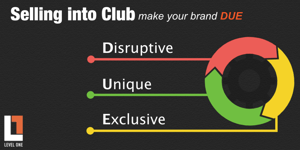 By: Jeremy Smith
By: Jeremy Smith
Each week we share insights from product and retail experts. This guest editorial comes to us from Jeremy Smith, COO and Co-Founder of Level One Marketing, a sales and marketing group focused on club representation and branding. Jeremy has personally helped brands like Chobani Greek Yogurt, EVOL Foods, GoRaw, Bob’s Red Mill and 5-Hour Energy enter Club.
On first glance, club retailers might not look like a good sales environment for younger food and beverage brands.
You may have an image of remote cinderblock warehouses, pallets stacked high with mainstream brands, or buyers that don’t want to work with smaller brands.
But take a closer look: and you’ll see enormous potential. Club members’ have an extremely high average household income and are almost always families buying in bulk.
Club buyers are strongly attuned to regional tastes and have created a ‘Treasure Hunt’ experience for their members who enjoy discovering new brands throughout the warehouse. Clubs are especially supportive of young regional companies with appealing brands. Their buyers are open to limiting product launches to as few as one to five warehouses, allowing smaller brands to test the waters with little risk.
Being in Club also creates a powerful sales “Halo Effect” for your entire business. Even if only one of your SKUs is at Club, its Members will be more open to buying your line at their “regular” retailers as they discover your full product line.
Club members are influential; they serve your brands at parties and bring snacks to their kids’ events. In other words, the Club channel is a perfect opportunity for unique, natural, organic and family-friendly brands. But brands also have to be set for its special challenges. Here’s how to know if you’re ready:
Are Your Resources and Systems Ready for Club’s Unique Requirements?
While the revenue potential is enormous, brands need to enter Club fully aware that it is a lower margin business than traditional retail. While that may worry young businesses accustomed to a certain level of profit per unit, the impact is softened by clubs’ truckload buying power. For some, growing production volume will be the key to negotiating substantial discounts on line time, ingredients, printing and packaging costs.
And then there’s the basic: cash. Costs and risk need to be carefully analyzed prior to approaching a Club buyer. You should anticipate investing in new specialized packaging and program support. Club retailers may let you test-launch your product with your current retail packaging and this approach can minimize the financial risks that come with Club-specific packaging, which often require large print runs. Should you go this route still plan on developing a strategy for developing your club specific packaging and make sure all of your numbers make sense prior to making any final decisions.
Club-specific package design must provide the right value for Buyers, Club members and account for the special demands of the Club warehouse environment. Your product will need to be ‘palletized’ properly so it displays well to compete on equal footing with established mainstream brands. It’s important for your Club specific packaging and brand messaging to reflect the Club environment in order to achieve maximum success. It should not just be a larger version of the product you are currently using out in retail. (More on this in a future column!)
Finally, in many cases Club retailers require approved third party plant audits before issuing a purchase order. This can be a challenge for younger companies working with co-packers that don’t have HACCP certification. Your broker should be familiar with Club co-packer requirements and guide you through the entire process.
Do You Have Existing Distribution?
When you do launch at Club try to start in a region where your current distribution is already established. In many cases we have seen much higher dollar sales per building at Club for those companies that follow this approach. The existing presence doesn’t need to be big; many of our success stories started as a regional brand or as start-ups with limited local distribution with annual sales ranging from as little as $400,000 to $4 million.
It’s still possible to succeed in Club without securing shelf space elsewhere, but there are so many potential synergies – volume manufacturing discounts and the aforementioned Halo Effect, just for starters – there are some cases where we don’t recommend a potential new client going in to Club until they can take advantage of these synergies across their entire business.
Do You Have Clean, “Better-For-You” Ingredient Decks? Do You Have Organic and GMO Free Offerings?
If you haven’t visited a Club warehouse lately, you’re in for a surprise. Clubs have come a long way from the old days of concentrating sales on electronics knock-offs, last year’s models, and family sizes of huge brands. Warehouses are now known not just for delivering consumer ‘value,’ but also for offering high quality products.
With an average household income higher than any other club retailer, Costco is the perfect place for organic and premium brands. It has always pushed hard to offer its members products with high-quality ingredient profiles, Made in the USA and certified GMO-free or USDA Organic. And sales figures clearly show that its members really respond to these brand attributes.
It’s common at Club to see a brand that looks very similar to the product offered at traditional retailers. A closer look at the ingredient deck may show it has been revised to be much healthier than the same brand sold elsewhere. Often these alterations were done at the request of the buyer.
Is Your Company and Brand DUE?
At Level One we coined the term “DUE”—Disruptive, Unique and Exclusive—to describe companies that can change a category. DUE products are likely to be new to the entire category, not just to a single retailer. It’s the type of competitive advantage few companies have, yet everyone knows it when they see it.
Chobani is one of the best examples of a company that has DUE firing on every level. While other companies were focused on other aspects of the yogurt category, Chobani saw Greek as an opportunity when no one else did. No other food company can claim to have grown a billion dollar business by launching its product via social media without spending millions on advertising. Chobani’s strong consumer relationships continue to propel its business today.
The Value of Partnering with a Club Broker
Make no mistake: Selling into club isn’t easy. Club retailers don’t add SKUs the same way traditional retailers do and this can make for a longer sales cycle for item placement.
For companies that have never approached Club using a broker can instantly provide you with credibility with buyers. Tapping in to a brokers years of experience working with Club can rapidly reduce the time it takes to gain item placement as well as increase your odds of success.
While there are an abundance of Club Brokers, finding the right Club Broker isn’t easy; it’s a given that every broker will tell you they have the best connections and references. Take your time, do your research to find the right one, and make sure you ask tough questions.
Here are a few to get you started:
- How did you make Brand X a success?
- What is your percentage of continually ordered items to rotational items?
- How long does it take to usually get an item placed?
- How do you help your clients be profitable at Club?
- What is your strategy for Club support programs and why?
- What are your failures and how did you deal with them?
- How do you deal with the buyers that request my value at cost?
- What experience does the broker have with your specific category?
When you speak with the brokers references make sure their stories mirror what the broker has told you.
Buyers may reach out to companies directly or connect at trade shows. You could of course work directly with them, but this may not be the best approach for selling to Club.
Without a broker you’re reliant on a buyer who could recommend programs and terms that benefit their business more than your brand. Even if you do find the right buyer, it’s unlikely they will have the time to collaborate with you on resource allocation, distribution or packaging the way that a broker can.
The best brokers focus on creating value and building support programs to benefit your brand.
Questions?
I’d love to hear from you whether you currently have experience selling into the Club channel or are considering entering the space for the first time. Join the discussion in the comments below.
After more than 30 years in strategic sales and marketing, Jeremy’s senior management and graphic arts resume reads like a roll call of iconic brands including Chobani Greek Yogurt, Bob’s Red Mill, EVOL Foods, GoRaw, Saffron Road, Gardein, 5-Hour Energy, Levi’s, Paramount Pictures, and Apple Computer. His vast experience launching and building brands anchors Level One’s unique ability to provide high-level design and branding services, a vital asset for companies looking to become widely recognized nationally.
